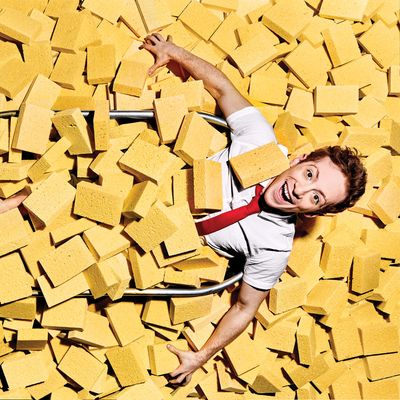
Literalists who arrive at SpongeBob SquarePants: The Musical hoping to see a man sing and dance in a big, yellow, sponge-shaped outfit are bound to be disappointed. Instead of mimicking a cartoon, the show’s young star Ethan Slater somehow inhabits its spirit. He wears a red tie and a pair of squarish pants, and exaggerates the right angles in his gymnast’s silhouette. “Three years ago, I was doing a pretty good impression of Tom Kenny,” Slater says of his attempts to mimic the man who voices the famous sponge on the Nickelodeon TV show in the musical’s early workshops. “But it’s become important that it’s not just an impression, but the voice is the embodiment of the character, and my version of the character.”
The musical — now on Broadway after a 2016 world premiere in Chicago — unites the contrasting sensibilities of Nickelodeon’s kids’ animation series with the sensibilities of its boundary-pushing director Tina Landau. Slater, who was cast when he was a sophomore in college in 2012, developed the character with an eye to both physical comedy — he cites Buster Keaton and Charlie Chaplin — and emotional truth. Think of it as a kind of koan: Try to be a cartoon, without doing anything too cartoonish. Or, as Slater remembers his director’s advice: “This isn’t Ethan trying to be SpongeBob’s level of energy. This is Ethan being SpongeBob.”
Let’s start at the beginning: Five years ago, you auditioned for this your sophomore year of college at Vassar?
I auditioned for a summer apprenticeship program, and the casting director, who was casting Romeo and Juliet at the time, called me a week later said we have this other thing, the “Untitled Tina Landau Project,” that we think you might be good for. The first audition was one scene from SpongeBob with both the names changed. It was from the episode where Squidward thinks that SpongeBob’s eaten a cake that’s a bomb, so they’re watching the sunset and Squidward thinks that his little buddy’s about to explode. It’s a total classic. And a physical comedy routine. It was sophomore year of college and I had stayed up until 4 a.m. the night before in the classic college fashion working on this routine.
The one thing I didn’t do was I didn’t try to do a SpongeBob impression because I had shockingly never tried a SpongeBob expression. What I decided to do was talk in a voice that’s just myself but a little higher pitched. I did that, and Tina Landau said, “That was great, thank you, come back in in two days and try the voice.” The second time I also had to do a physical comedy routine. Then, I tried the voice, and I don’t know exactly what Tina thought, but I think she thought, Good enough for now.
That’s interesting because, in the musical, you’re not totally imitating SpongeBob.
It was a process over five years. Three years ago, I was doing a pretty good impression of Tom Kenny [who voices SpongeBob in the cartoon]. I worked really hard at getting his voice down, and I think my impression is okay. But it’s become important that it’s not just an impression, but the voice is the embodiment of the character, and my version of the character.
It must have felt intimidating to play something so well-known.
It must have been way more intimidating for Tina, because this was her concept and she was driving it, but it also meant that I wasn’t 100 percent thinking of this as what was going to be my Broadway debut. I was thinking about this as each step along the way was in and of itself an incredibly fulfilling creative experience. The magnitude of being able to make my Broadway debut as SpongeBob in SpongeBob SquarePants really only started to hit me when we took it out of town.
When you’re playing SpongeBob onstage, you’re not wearing a square suit or anything, but there’s still a lot that’s familiar. It feels like you keep your elbows are down a lot to feel square, for instance. What else do you do to get the character?
That was a lot of it, the silhouette, finding the right angles of my body. But then, also, finding the things that make you look really cartoonish — doing backbends and handstands and jumping around. One of the things that has made the show what it is is Tina’s insistence on grounding everything, being outlandishly cartoonish, but at the same time making sure it all is coming from the truthful emotional place. The way Tina framed it was fast on the outside, slow on the inside.
The emotional core of the musical’s SpongeBob’s friendship with Patrick and Sandy. How did you guys develop that?
One of the best throughlines of the past five years for me has been working with Danny Skinner. He plays Patrick. For both of us, this was one of our first experiences working in New York. We became fast friends the day before the first day of the workshop. He reached out and said, “Hey we’re going to be working together. We’re playing best friends. Want to go get Thai food?” And then I went to school with Lilli Cooper [who plays Sandy], so we’ve known each other for a long time. Not that you need to have been long-time friends with castmates to show friendships on stage, but it certainly helps.
The concept of a SpongeBob musical is probably a little hard to explain to someone.
I’ve had the conversation with friends, or people that I just met, and they’ll say, “What are you working on?” and I’ll say, “I’m working on SpongeBob.” Before we’d opened in Chicago, people would say, [sighs] “A job’s a job.” My response to that was always, “No no no, this is actually really a great job, this is an incredible show!” It’s an original story which I think is important. I think a lot of people might assume that it’s an adaptation of some episode you’ve already seen and it’s not.
Were you a SpongeBob fan growing up?
I would say I’m the normal level of SpongeBob fan, which is that it’s been out since I was a kid and it’s part of the zeitgeist. It is our sense of humor. I didn’t have cable at my house growing up so I would watch it at friends’ houses and I’d watch it at my grandma’s house.
What did it feel like when you got to Broadway?
It’s still really surreal — it’s like a new gift every day. I mean, opening night on Broadway was really unbelievable, there’s actually no way to describe it except that with each relationship that I have with somebody in the show or in my life, I had a moment of this is one of those things that we’ll never forget. Danny and I have been working towards this for a long time together, and we didn’t know that it was ever going to happen with this show.
When you’re doing eight performances a week, how do you maintain your energy?
I have a 90-minute slow warm up to get ready. I’ve got to be stretched out. There are days when I’m really tired moments before the show, but even on those days, as soon as I’m out on stage, I just feel instantly energized because I’m in the Palace Theater, and not only am I sharing the stage with some of my best friends, this incredible family of a cast, and I’m sharing it with this audience that’s overjoyed to be there and, you know, the ghost of Judy Garland.
So much of SpongeBob is this physical comedy that’s almost vaudevillian. Is that something that you thought you were interested in or excelled at?
It’s honestly not something I thought that I excelled at going into it. I’ve always loved the Marx brothers and Charlie Chaplin. Buster Keaton is my personal favorite and I watched a lot of that growing up. Physical comedy and musical theatre were never actually in my main focus at school. I was more of a dramatic actor. I always thought I was better at that. I still think I might be.
Were your friends surprised that you were doing this big physical comedy role?
My friends were a little bit. Maybe a little less so because when we we’re messing around I was do bits and falls and dumb things.
It wasn’t like, “Ethan is deadly serious how could be?”
No! But it was a little bit like, Ethan does Sam Shepard plays, how is he … ? But it also feels pretty natural. It was somewhere in the middle.
At this point, I’m sure you’ve watched a ton of SpongeBob for work and for fun. Do you have any favorite gags from the TV show?
My favorite joke is at the end of the episode “Bubble Buddy.” Do you know that episode?
Where SpongeBob makes a bubble friend and pretends it’s real and Squidward tries to pop it?
Yeah, and when they’re about to stick a pin in him and, he’s like, “Hey don’t I have a say in this?” and he makes a bubble fedora, puts it on, hails a bubble cab, and floats away. I think that’s brilliant. It reminds me of the Buster Keaton bit where he’s running and hiding from these guys who are chasing him, and he jumps into a tire on the back of a car to hide. The car drives away and it turns out the tire wasn’t attached. It’s the same school of thought where you see one thing, and then at the very last second you tilt the angle of the lens a little bit and it’s something totally different. The one rule is that there are no rules.
This interview has been edited and condensed.





